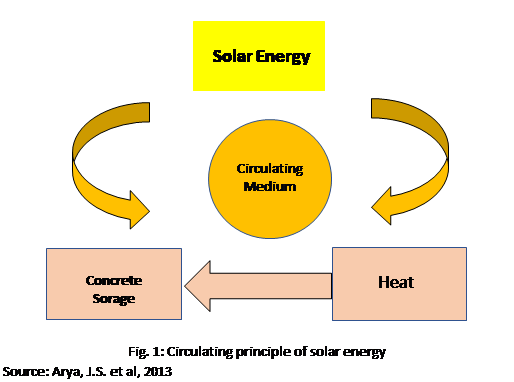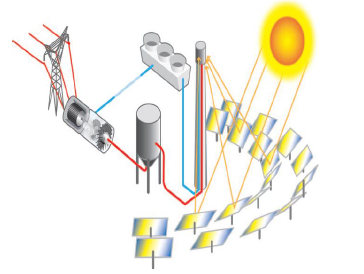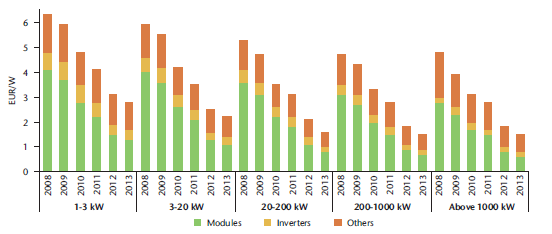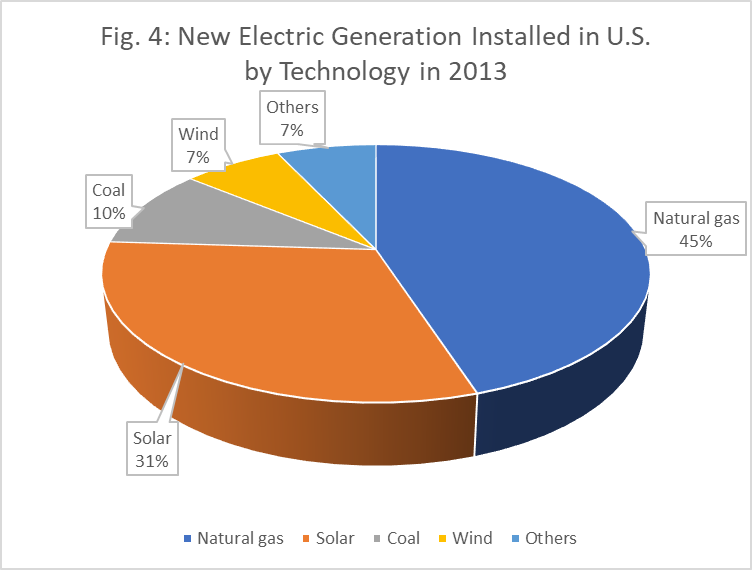Trends in Solar Energy, Systems, and Products: Clean energy is one of the most talked about topics of current discussions in the energy sector all over the world. The topic has received further support after the Paris Agreement on Climate Change, where 197 countries signed the agreement for clean energy. Transitioning from fossil fuels to renewable sources of energy such as solar and wind is the focus of energy policy of the various countries of the world to achieve the social, economic and environmental development. According to a report prepared by the FS-UNEP (2017), the renewable energy will change the lives of 1.2 billion people who have no electricity.
Renewable energy consisting of solar and wind energies and some others will not only create new jobs and commercial opportunities but will reduce the air pollution that has been the cause of the millions of lives each year. The investment in renewable energy capacity has superseded that in fossil fuel generation for the consecutive five years in a row. FS-UNEP (2017) reports that excluding large hydro power, about 138 gigawatts of new power capacity came online; accounting for approximately 11 gigawatts more than in the previous one year. This resulted in 23 per cent cost reduction than in 2015, partly due to the falling cost of clean technology. For example, the average dollar capital expenditure per megawatt dropped by over 10 per cent for solar photovoltaics and wind offering better returns to the investors.
Adani Group in India, has taken the advantage of the cheaper set-up costs by completing a massive solar plant in India, where generating energy from renewables costs almost the same as traditional methods. The plant in Tamil Nadu covers 10 square kilometers and can power 150,000 homes. Adani Group will not only make money, but will also help India to meet its commitment to the Paris Agreement, by generating 40 per cent of its electricity from non-fossil-fuel sources by 2030 (FS-UNEP, 2017). This project created 8,500 jobs in the building phase. The rapid shift to clean renewable energy, the solar and the wind energy, is not only going to tackle the pollution and ending the suffering of vulnerable communities, but will be boosting long-term economic prosperity and stability.
Trends in Solar Energy, Systems and Products
Conversion of Solar Energy into electricity
Solar energy can be converted into electricity by two methods: One, the thermal, which is based on concentrating solar power by mirrors or another type of reflectors to produce high temperature to generate water vapor or other liquids with high pressure to rotate turbines to generate electricity and second by making use of photovoltaic (PV) effect to convert solar power to electric power directly (Wasfi, 2011). A photovoltaic complete system usually consists of photovoltaic units, batteries, charging controllers, inverters, load controllers, circuit breakers, and wiring.
Electricity generation by Solar Photovoltaic
Several technologies are available that can be used to produce electricity based on the solar photovoltaic principle. Crystalline silicon at the moment is the main technology used commercially, but there are other technologies at the research stage to develop more efficient solar cells. Also, Read: Utility patent drawings
The efficiency of silicon solar cells is in the range of 13-18%. Solar cells made of 1 m2, produce about 140-170 W peak, but the average (with no tracking facilities) solar power produced within the 8 hours from 8 am to 4 pm is about 70-85 W/m2.
The cost of photovoltaic systems has come down, especially during the past ten years. With the advancement of technology, the efficiency of most systems is going up and thereby the cost is coming down (Kamlapur and Udaykumar, 2012).
Principle of Energy Storage
The circulation medium is heated by the synchronous tracking and non-tracking solar collector. The circulating medium is then injected into the heat exchanger which is set in a concrete pile with the help of a circulation pump. After the exchange of heat between the heat exchanger and the concrete pile, the circulation medium is pumped to a synchronous tracking solar collector. The solar energy gathered by synchronous tracking and non-tracking solar collectors is stored in the underground concrete energy storage pile (Zhao, et al, 2010). Fig. 1 shows the circulating principle (Arya, J.S., et al., 2013).






Source: Arya, J. S. et al., 2013
Fig. 2 shows the power generation system of solar energy in which steam generated drives the steam turbines coupled with alternator.
Trends in Solar Energy
Solar energy is an important source of energy among the available sources. It offers clean energy. The trends in solar energy are discussed here.
The global challenge of clean energy
The overall aim to advance global development is to limit the global mean temperature increase to 2 degrees Celsius (⁰C) in the long term. To achieve this target, number of technological development are to be taken up. The required technology development includes both on the demand side as well as on supply side.
Rationale for Solar photovoltaic power
The roadmap prepared by IEA envisions up to 16% of the global electricity for solar PV with 6300 Twh to be generated in 2050, which is higher than the 4500 Twh foreseen in the2010 roadmap. IEA (2014) points out that solar energy is widely available throughout the world and can contribute in this direction. The security of supply of energy is ensured as there is no risk or constraints due to increase in fuel price. Solar power increases the diversity protects from price volatility of fossil fuels and therefore stabilizes the cost of electricity in the long run. Solar energy offers other benefits as well. It does not emit greenhouse gas (GHG) during operation and does not emit other pollutants, such as oxides of Sulphur and nitrogen. In case of hot countries, large quantities of fresh water are needed for cooling of thermal power plants. Solar energy does not pose any problem in hot and dry regions. The importance of solar energy increases to meet these challenges. Also, Read: Design patent drawings
Impressive progress of the PV industry in the past 5 years
The PV industry has made impressive progress in the past five years (Table 1). Manufacturing capacity has considerably increased, and a move of module manufacturing from European countries and the United States to Asia, notably China and Chinese Taipei. Market prices have drastically reduced – by factor of five for modules, and by a factor of almost three for systems. The global rate of annual new-built capacities, which was 7 GW in 2009, was 5 times higher in 2013. Grid-connected PV systems have been built in various capacities from just a few KW to hundreds of megawatt (MW) (IEA, 2014). Off-grid systems are even of smaller capacity and at the same time offering high valued power far away from electricity network. Simultaneously, along with small capacity plants, 20 utility-scale plants with generation capacity of more than 100 MW operate in different parts of the globe, mostly in China and the United States (IEA, 2014). Burger (2014) reports that more than 1.3 million solar power plants in Germany produced 30 TWh in 2013 which was 5.3% of the electricity consumption in Germany. The total rated capacity of these plants at the end of 2013 was 36GW. Same was the case of Italy where PV systems generated 22 TWh in 2013 with total rated capacity of 17 GW. Solar power generation in Italy in 2013 was 7% of the electricity consumption. According to PVPS IA (2014) and RED (2014), five other countries – Belgium, Bulgaria, Czech Republic, Greece and Spain recorded PV generation more than 3% of electricity demands in those countries.
Table 1: Progress in solar PV markets and installations globally during the period 2009 and 2013
| End of 2009 | End of 2013 | |
| Total Installed capacity | 23 GW | 135 GW |
| Annual Installed capacity | 7 GW | 37 GW |
| Annual investment | USD 48 billion | USD 96 billion |
| Number of countries with > 1 GW installed | 5 | 17 |
| Number of countries with > 100 GW yearly market | 9 | 23 |
| PV Electricity generated during the year | 20 TWh | 139 |
| PV penetration levels | % of yearly electricity consumption | |
| Europe | 2.6% | |
| Germany | 5.3% | |
| Italy | 7% | |
Source: IEA (2014)
Technology improvements
PV cells are semiconductor devices. They generate direct current (DC) electricity. Silicon cells are made up of sliced ingots or castings of highly purified silicon. A charge- separating junction is created during the manufacturing process. Passivation layers and an anti-reflective coating are deposited followed by addition of metal contacts. Modules are made up of cells placed in groups, transparent glass on the front, a weatherproof material for the back and often a surrounding frame. The modules are then combined to form strings, arrays and systems. Also, Read: Patentability Searches
Capacities ranging from less than 1 watt to gigawatts, PV can be used for on-grid and off-grid applications. Grid-connected systems require inverters to transform DC power into alternating current (AC). The balance of system (BOS) includes inverters, transformers, wiring and monitoring equipment, as well as structural components, which are used for installing modules on building rooftops or facades, above parking lots, or on the ground. Installations can be fixed or track the sun on one axis (for non- or low -concentrating systems) or two axes (for high-concentrating systems) (IEA, 2014).
The standard PV technology in space applications consists of multi-junction cells, which have recently been introduced to the terrestrial market in concentrating photovoltaics (CPV) systems and are used with several large-scale plants (50 MW each) in operation or under construction. Some manufacturers also sell hybrid PV-thermal panels that deliver both heat and electricity.
Even more impressive progress has been made with respect to manufacturing. The amount of specific materials (silicon, metal pastes, etc.), the energy consumption and the amount of labor required to assemble modules were all significantly reduced.
Improved efficiency of commercial modules
In the last 10 years, the average efficiency of commercial silicon modules has improved by about 0.3% per year and reached 16% in 2013. Efficiency up to 21% have been achieved by the best-performing commercial modules, based on back-junction, interdigitated back-contact (IBC). With heterojunction (HTJ) technologies, the efficiency over 19% have been achieved with excellent performance ratios. Modules are usually guaranteed for a lifetime of 25 years at minimum 80% of their rated output, and sometimes for 30 years at 70% (IEA, 2014). TF modules also saw increases in efficiencies, with commercial Cadet TF, in particular, reaching 15%.
Improved performance in manufacturing
Manufacturing of PV systems has made significant progress over the years. The amount of specific materials (silicon, metal pastes, etc.), the energy consumption and the amount of labor required to assemble modules have significantly reduced.
Cost reduction of PV systems
The costs of PV systems have considerably reduced during the period 2008-2013 in several countries. In Italy, prices for non-module components of PV systems dropped significantly (Figure 3). In other countries, especially, in the United States, the reductions were relatively much smaller. The reduction in module costs was the main driver of the fall in system costs.



Source: Gesture dei Servizi energetici (GSE) (2014), PV in Italy: Generation Costs and Value Chain, May, Rome
In 2013, the cheapest large-scale, ground-mounted PV systems could cost less than USD 1.50/W, a price that was expected to apply in 2019 or 2017 at the earliest. Module prices seemed to have stabilized in 2013, but system costs have continued to fall, with cost reductions in California, for example, ranging from 10% to 15% depending on system size in the first half of 2013 (Barbose et al., 2013). In Japan, costs of residential PV systems fell from USD 5.9/W in 2012 to USD 4.64/W in 2013 – a 21% reduction. Also, Read: Patent Invalidity Search
PV systems Vs. conventional power systems
The costs of PV modules and PV systems is rapidly reducing with the development of global PV market. The levelized cost of energy (LCOE) from PV systems is already below retail electricity prices (per-kWh charge) in several countries, and rapidly approaching the level of generation costs from conventional alternatives, especially new coal with strict air pollutant emission standards, new nuclear plants with increased safety standards, or new gas plants in areas with high gas prices (IEA, 2014).
Crystalline Silicon (c-Si) modules
Crystalline silicon (c-Si) modules, whether single- (SC-Si) or multi-crystalline (mc-Si), take a major share (90%) of the current PV market. The market of thin films (TF) of various sorts was about 16% in 2009 and has come down to about 10% of the market in 2014. Concentrating photovoltaics (CPV), although growing significantly, represent less than 1% (IEA, 2014). Decentralized systems occupy approximately 60% of the global market, while centralized, utility-scale systems represent close to 40%. Off-grid systems, which were prominent in a much smaller market at one time, now account for 1% at most. A significant shift has been seen in the manufacturing industry in the last few years. The PV module manufacturing industry has shifted from Europe, particularly Germany, to Asia, mostly China and Chinese Taipei.
Miltonian (2015) reports that Concentrated Photovoltaic (CPV) installations are expected to rise to almost 800 MW in 2020, up from roughly 100 MW in 2012. He further argues that installations of both High-Concentration Photovoltaic (HCPV) and Low-Concentration Photovoltaic (LCPV) systems will expand at double-digit percentages every year through 2020.
In 2013 the Fraunhofer Institute for Solar Energy Systems ISE, Soitec, CEA-Leti and the Helmholtz Center Berlin jointly announced a new record efficiency of 44.7 percent for a four-junction solar cell, which measured at a concentration of 297 suns was reported joinly in 2013 by Fraunhofer Institute for Solar Energy Systems ISE, Soitec, CEA-Leti and the Helmholtz Center Berlin. In November 2014 the French-German partners achieved a new world record of 46.0% efficiency for their four junction cell at a oncentration of 508 suns. Also, Read: Freedom-to-operate searches
The cell efficiency of HCPV systems, which was at 40 to 42 percent at Standard Test Conditions (STC) in 2015, is expected to reach almost 50 percent by 2020. Such cells, used with concentrating optics, will yield commercial- system efficiencies approaching 40 percent, compared to the less than 35 percent conversion rates typical in 2015. Consistent improvements in technology and gradually decreased costs will drive HCPV systems to superior cost efficiency, making HCPV an increasingly viable rival to conventional solar-generating solutions.
Grid-connected PV energy storage installations
The growth of PV industry has been on a very positive note. The capacity installation of PV systems was estimated at 180 GW by the end of 2014. This was expected to increase more than three times to reach 775MW in 2015 (Wilkinson, 2015). The progress in generating significant amounts of power from solar energy can create huge economic and environmental benefits. Solar generation is intermittent and fluctuates in a relatively unpredictable way. The power system is changing from the traditional and relatively simple system of one-directional flow—from large-scale conventional generators through transmission and distribution lines to consumers, to an increasingly complex mix of small, distributed generators and consumers at all points in the electricity grid. Also, Read: Patent Landscape Search
The changing pattern of power supply and demand, falling cost of PV and rising cost of electricity from the grid is leading towards energy storage in solar industry. The market for PV energy storage systems (PVESS) is expected to rise sharply with wide-scale adoption.
Some of the companies in USA like Green Charge Networks, Stem and Coda Energy are also helping to drive this market by offering their systems to end-users with no upfront cost. They own the storage, site it at the customer’s building and pass on a proportion of the savings generated, creating an extremely compelling proposition. This attractive business model was the driver to grow the North America market by over 200 percent to achieve nearly 80 MW of commercial PV energy storage installations in 2015.
There is a growing interest in pairing storage with utility-scale PV systems to integrate into the grid. However, in areas with high levels of renewable penetration, or on island grids, the impact of fluctuations on the output of large PV systems can pose significant challenges to the grid’s stability.
IHS (2015) predicted fast growth of utility-scale PV energy storage installations to over 350 MW in 2015 from the 50 MW in 2014.
Monocrystalline technology gaining market share
Over the period monocrystalline technology is leading in comparison to multicrystalline technology in the global PV business. The strong development of the residential rooftop segment in Japan and by recent increased demand for high-efficiency products, Monocrystalline technology has gained market share due to greater solar efficiency in 2015. Jin (2015) argues that Multicrystalline technology dominated the market in 2013 taking 80% of the market share. But since than monocrystalline technology is showing a trend of market share.
It is expected that monocrystalline technology will grow in future due to increased efficiency in global supply chain as well as in manufacturing operations that will drive the decreased costs on a dollar-per-watt basis. According to Jim (2015), a standard monocrystalline cell has a 2 percent higher efficiency on average than multicrystalline, not to mention the N-Type monocrystalline cell that can reach 24 percent. Current average production cost is $0.38/W for monocrystalline cells and $0.34 per watt for multicrystalline cells. Average selling prices are at $0.44 per watt for monocrystalline and $0.38 per watt for multicrystalline cells. Thus, the average margin for monocrystalline cells is 5.7 percent higher than for multicrystalline.
Systems up to 100 kilowatts
Cook (2015) expected distributed photovoltaic (DPV) systems—i.e., those sized 100 kilowatts (kW) or smaller—to account for 30 percent of global installations in 2015, with 15.7 GW projected, up from 13.2 GW in 2014. Japan was the expected to be the largest market in 2015 where DPV accounting for nearly 70 percent of installations. It was forecasted that the U.S. will install more than 2.2 GW of DPV in 2015, as net metering and third-party ownership models continue to drive this market.
Three-phase string inverters
Three-phase string inverters were driven because of attractive prices and the market was to reach in 2015 to more than $2.2 billion, which was equivalent to one-third of the worldwide market for inverter (Gilligan, 2015). The low prices will allow three-phase string inverters with a capacity less than 60 kilowatts (kW)—to increase their penetration rate in both commercial and utility-scale installations. Estimated shipments in 2016 of three-phase string inverters was expected to exceed 15 GW, up 31 percent from 2014. A surge was expected in important markets like China and Japan, whose combined shipments will account for 7.6 GW of the total (Gilligan, 2015). Large historical shipments of three-phase string inverters in the United States and China indicate a bright future for string inverter adoption.For many years, string inverters, rather than large central inverters, have been utilized for major commercial or utility-scale installations in key PV European markets such as Germany and Italy. Three-phase string inverters are being adopted in non- European territories like the United States and China. Also, Read: Freedom to Operate FTO Search Report Sample
Solar energy trends in the United States
The driving forces to promote solar energy in the United States include falling photovoltaic (PV) prices, strong consumer demand, available financing, renewable portfolio standards (RPSs), and financial incentives from the federal government States, and utilities (IREC, 2014). Thirty-four percent more PV capacity was installed in 2013 than the year before. Three large concentrating solar power (CSP) plants with a combined capacity of nearly 0.8 GWAC were completed at the end of 2013. 31 percent of all electric power installations completed in 2013 were solar power plants. The federal Investment Tax Credit (ITC) of 30 percent of the installed cost has acted as an important incentive for most installations. An 11 percent fall in Installed prices for distributed PV installations was witnessed in 2013 and has fallen by 44 percent since 2009 (IREC, 2014). The prices of some individual system components, especially modules, have fallen even more. Due to lower prices, consumer demand for solar installations has been increasing.
Percentage share of solar energy in electric generation in the United States
U.S. solar installations accounted for about 12 percent of the global total in 2013 and ranked third globally. Germany and other European markets had been the largest global markets for many years. However, in Germany, less PV capacity was installed in 2013 than in 2012.
In 2013, solar installations (including both PV and CSP) accounted for 31 percent of new electricity generation installed during the year (Figure 4). In 2012, PV installations accounted for 12 percent of new additions. The electricity generated by PV and CSP installations supplied 0.4 percent of all electricity generation in the U.S. during 2013. Also, Read: Patent Drawing Services



Source: Energy Information Agency (IEA 2014) with IREC PV data
The capacity of 2013 PV installations increased by 34 percent to 4.6 GWDC compared with 2012. The cumulative installed grid connected PV capacity reached to a level of 12.1GWDC, 82% of which was installed in just three previous years. In 2013, 0.9% GWDC were installed on residential buildings, 1 GWDC at non-residential sites and 2.70.9% GWDC in the utility sector. According to IREC (2014), some of the highlights about solar energy in U.S. are:
- California was the most important market in 2013. Fifty-seven percent of U.S. capacity installed in 2013 occurred in the Golden State California. The installed capacity during 2013 was 161 percent greater than what was installed in 2012.
- Residential capacity installed in 2013 grew by 68 percent in the U.S., fueled by the increasing use of leases and third-party ownership of these systems. Over 145,000 residential PV systems were installed during the year.
- Utility sector capacity installed grew by 47 percent. Ten PV installations, each larger than 100 MWDC, were completed in 2013.
- Hawaii had the highest per capita installed capacity of PV systems. More than 75 percent of grid-connected PV system capacity installed in 2013 was concentrated in California, Arizona and North Carolina.
Concentrating Solar Power
- 2013 witnessed the most CSP capacity ever installed in the United States in a single year. Three new CSP solar plants with a total capacity of 766 MWAC were completed, the first in the U.S. since 2010.
- In the near term, the prospect for growth in solar installations was bright in all sectors. The residential sector was growing in a large number of states, and many utility sector projects were under construction or contracted and were planned to be completed in 2014 or later. The federal ITC continued falling prices, state RPSs, and ongoing net metering policies sustained the market.
Conclusions
Solar energy is an important renewable source of energy. Though, the availability of solar energy depends upon weather conditions technological developments in recent years and support from governments in various countries of the world are going to push the availability of this power. This source of energy is going to replace the need for fossil fuels to a considerable extent.
Reference
Arya, J.S., et al., 2013. Recent Trends in Solar Energy Generation. Association of Computer Electronics and Electrical Engineers. 750-755.
Barbose, G. et al. 2013. Tracking the Sun VI, Berkeley Laboratories, Berkeley, CA, United States.
Burger, B. 2014. Electricity Production from Solar and Wind in Germany in 2013. Fraunhofer Institute for Solar Energy Systems, Freiburg, Germany, January, 2014.
Cook, Lauren. 2015. Systems upto 100 Killowatts to account for 30 percent of global installation In 2015 (in HIS. 2015. Top Solar Power Industry Trends in 2015). 15-16.
FS-UNEP. 2017. Global Trends in Renewable Energy Investment 2017. A publication of Frankfur School- UNEP Collaborating Centre , GmbH. 1. 2015.
Gilligan, Cormac. 2015. Three-phase string inverters to account for one-third of global solar inverter revenue in 2015 (in HIS. 2015. Top Solar Power Industry Trends in 2015).19-20.
GSE (Gestore dei Servizi energetici). 2014. PV in Italy. Generation Costs and Value Chain, Rome, May.
IEA. 2014. Technology Roadmap:Solar Photovoltaic Energy. International Agency, Paris, France. 1-60.
IERC. 2014. U.S Solar Market Trends 2013. A publication of Interstate Renewable Energy Council, Inc. (IREC). 1-29.
IHS.2015. Top Solar Power Industry Trends for 2015. A publication of IHS Technology.
Jin, Jessica. 2015ine technology to increase market share in 2015 (In HIS. 2015. Top Solar Power Industry Trends in 2015). 13-14.
Kamalapur, G. D. and Udaykumar, R. Y. 2012. Rural Electrification in the Changing Paradigm of Power Sector Reforms in India. International Journal of Electrical and Computer Engineering. 2 (2). 147-154.
Melkonyan, Karl. 2015. CPV to see accelerated growth in 2015 (In HIS). 3 -6. . 2015. Top Solar Power Industry Trends in 2015
PVPS IA (Implementing Agreement for a Co-operative Programme on Photovoltaic Power Systems).2014. PVPS Report Snapshot of Global PV 1992-2013, www.iea-pvps.org.
RED (RED electrica de España) (2014), The Spanish Electricity System – Preliminary Report 2013, RED, Madrid, Spain, www.ree.es/sites/default/files/downloadable/preliminary_report_2013.pdf.
Wasfi, Mahmud. 2011. Solar Energy and Phovoltaic Systems. Journal of Renewable and Sustainable Energy (JRSE). 1-8.
Wilkinson, Sam. 2015. Grid-Connected PV energy storage installations to triple in 2015 (In HIS. 2015. Top Solar Power Industry Trends in 2015). 9-10. Zhao, Yan; Zhao, Dajun; Yao, Yirong; Fang, Xin; Li, Shousheng. 2010.
Development of Solar Energy Underground Seasonal Storage Device and Its Parameters Measuring System. Information Engineering (ICIE). 2010 WASE International Conference, Beidaihe, Hebei. 231 – 234.
Related Articles:
- Plastic Trends in USA (Specific Use in Automotive Sector)
- Safety in Cement Plants and Technology
- Is Wastewater Coagulation an efficient water treatment method?
- Solid-State Batteries: Unleashing the Power of Tomorrow
- Unveiling Supercapacitors: Revolutionizing Energy Storage
- Gamechanger: Sodium-ion batteries may make EVs far more affordable
